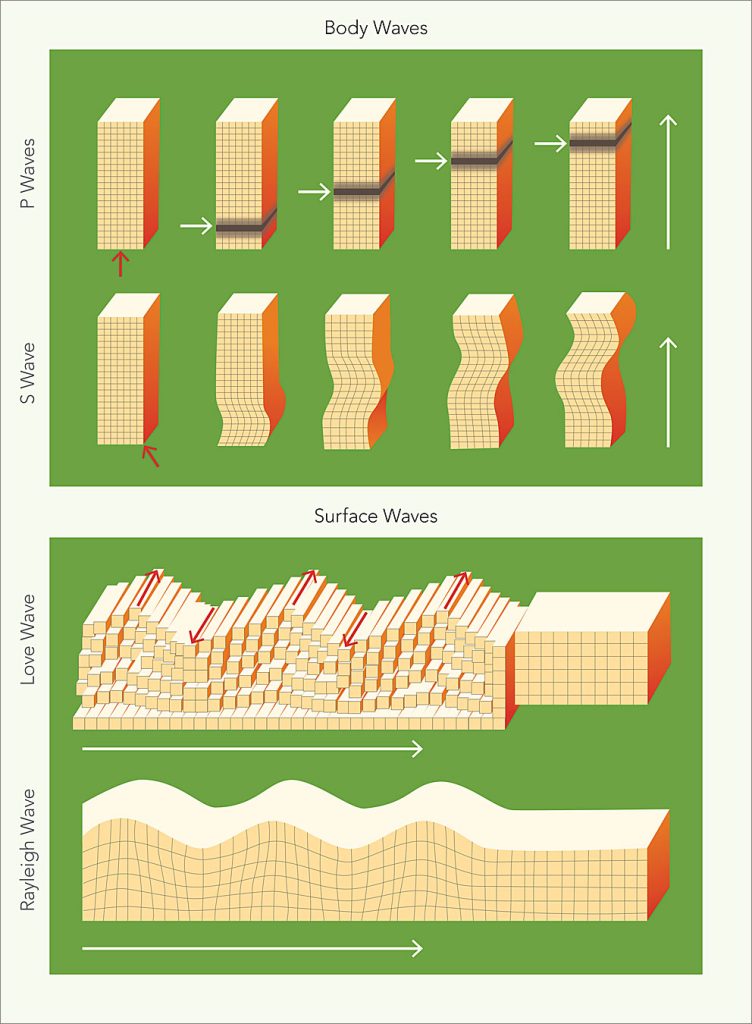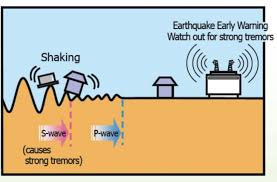Earthquake Early Warning (EEW) systems are crucial tools designed to detect seismic activity in real-time and provide advance notice of impending earthquakes.
These systems use a network of seismic sensors to detect the initial, less damaging seismic waves (P-waves) before the more destructive waves (S-waves) arrive. The goal is to give people and infrastructure a brief but critical warning to take protective actions, such as seeking shelter or halting hazardous activities.

EEWs are especially valuable in earthquake-prone regions, helping to minimize injury, save lives, and reduce economic losses. As technology advances, these systems continue to evolve, improving their accuracy and response times, thereby enhancing preparedness and resilience in the face of seismic threats.
Read More: An Overview of Earthquake Early Warning Systems
P-Waves, S-Waves, and Earthquake Warning Systems
Earthquake early warning systems are designed to detect the initial, non-destructive primary waves (P-waves) that move quickly through the Earth’s crust, ahead of the more destructive secondary waves (S-waves).
The time delay between the arrival of these waves determines the amount of warning that can be provided. This interval is longer the farther a location is from the earthquake’s epicenter. For large, distant earthquakes, this delay typically ranges from 60 to 90 seconds.

A general guideline is that for every two kilometers from the earthquake’s origin, the warning time increases by one second.The success of these warning systems relies on the precise detection of P-waves and the ability to distinguish them from false-positive ground movements caused by local activity.
The table below outlines the distinguishing characteristics of P-waves and S-waves.
What to Do in the First Few Seconds
Even a brief warning of just a few seconds can make a significant difference in mitigating the impact of an earthquake. For the general public, immediate protective actions are essential. Wherever they are, individuals should drop, cover, and hold on.
At home, turning off stoves is crucial to prevent fires. While driving, it’s important to safely stop the vehicle and remain inside until the shaking subsides.For emergency responders, automatic systems should be triggered, such as opening fire station doors, turning on lights, and alerting response teams.
Medical professionals should halt sensitive procedures, and trauma centers must prepare for incoming emergency cases.Additionally, emergency plans should be activated for outlying facilities, and utilities must secure power stations and distribution infrastructure to safeguard against damage from strong shaking.
Industries should focus on personnel safety and initiate shutdown procedures, including isolating hazardous materials. Businesses must move workers to safe locations, ensure elevators are either out of service or have their doors open, and place sensitive equipment in a secure mode to avoid damage.
Frequently Asked Questions (FAQs)
What is an Earthquake Early Warning (EEW) system?
An Earthquake Early Warning system is a network of sensors that detect seismic activity, providing short notice before destructive earthquake waves (S-waves) reach populated areas. This allows people to take protective actions.
How does an EEW system work?
EEW systems detect the first, less destructive seismic waves (P-waves), which travel faster than the more damaging S-waves. The system then sends out warnings based on the distance from the earthquake’s epicenter and the estimated arrival time of the S-waves.
How much warning time can I expect from an EEW system?
The amount of warning time varies depending on the distance from the earthquake’s epicenter. For large, distant earthquakes, the warning can range from 60 to 90 seconds. The farther you are from the epicenter, the longer the warning time.
What should I do if I receive an earthquake warning?
If you receive a warning, take immediate protective action. Drop, cover, and hold on, especially if indoors. If you’re driving, pull over and stop. At home, turn off stoves or other potential fire hazards.
How accurate are earthquake early warnings?
Earthquake early warning systems are highly accurate in detecting P-waves. However, their effectiveness depends on the timely detection of seismic activity and the ability to differentiate between real earthquakes and local ground vibrations.
Who receives earthquake warnings?
Earthquake warnings can be sent to individuals via mobile alerts, emergency responders, businesses, and utilities. In some regions, systems may also automatically activate safety measures, such as opening fire station doors and alerting medical facilities.
Conclusion
Earthquake Early Warning systems represent a critical advancement in seismic safety, providing communities with valuable seconds to minutes of warning before the most damaging earthquake waves arrive. Although these systems cannot prevent earthquakes, they offer an invaluable opportunity to mitigate the potential loss of life and property by enabling timely protective actions.

